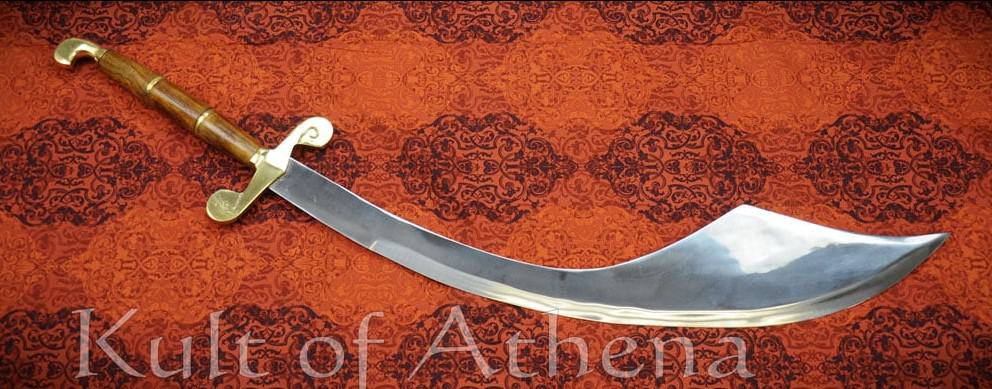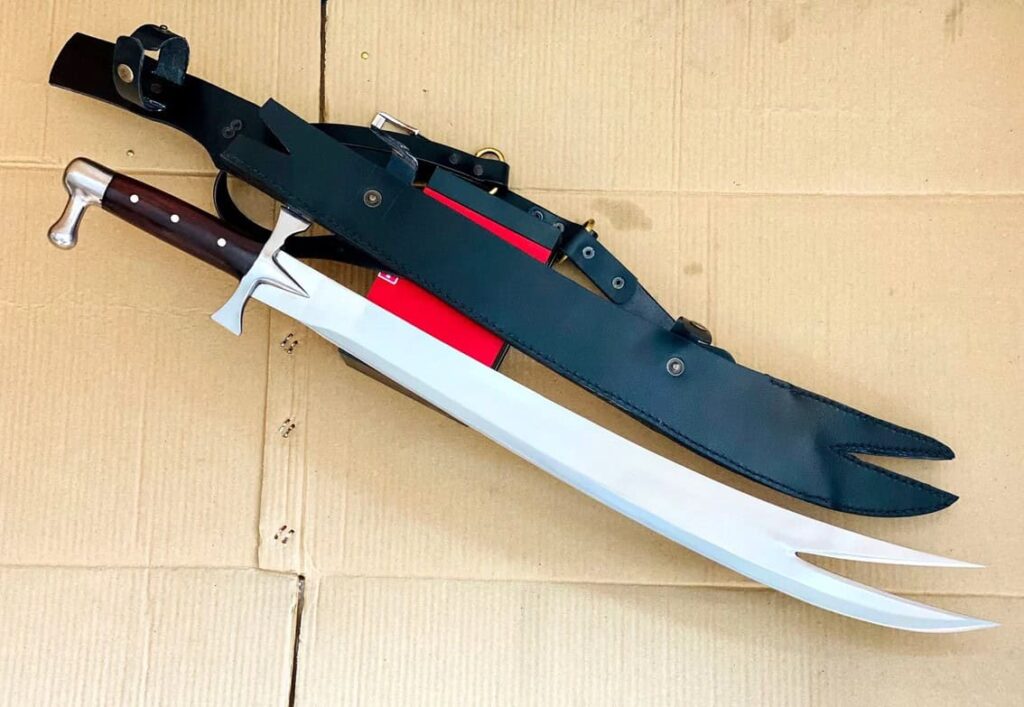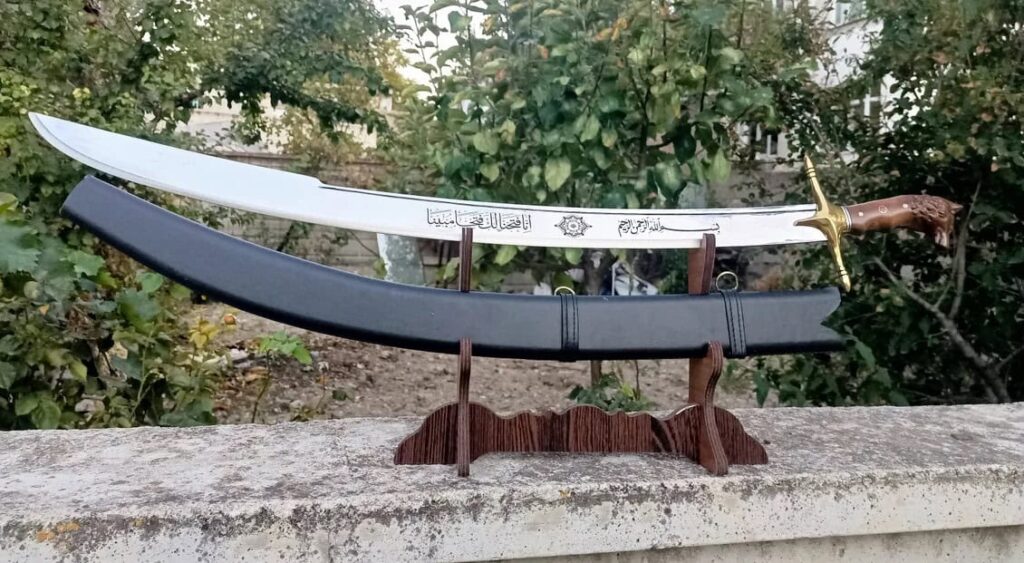What is a Scimitar?
TLDR: A scimitar is a curved, single-edged sword traditionally used in Middle Eastern and South Asian cultures, known for its distinctive, sweeping blade designed for slashing.
When I think of iconic swords, the scimitar always comes to mind. It’s a curved, single-edged blade that’s been a staple in Middle Eastern warfare and culture for centuries. You might’ve seen one in movies or video games, often wielded by swashbuckling heroes or fierce desert warriors. But there’s more to this sword than just its distinctive shape.
The scimitar isn’t just one specific sword, but rather a family of blades that share similar characteristics. They typically have a curved blade that widens towards the tip, making them excellent for slashing attacks from horseback. The word “scimitar” itself is a bit of a catch-all term that Westerners have used to describe these curved swords from the East.
Originating in the Middle East, the scimitar spread across various cultures, each putting their own spin on the design. From the Persian shamshir to the Turkish kilij, these swords have a rich history that’s as varied as the regions they come from. In this article, we’ll dive into what makes a scimitar unique, its historical significance, and why it continues to captivate sword enthusiasts like myself to this day.
Scimitar Physical Characteristics
When you pick up a scimitar, the first thing you’ll notice is its distinctive curve. Unlike the straight blades of European longswords, a scimitar’s blade sweeps gracefully forward. This curvature isn’t just for show – it’s designed to maximize cutting power, especially when swung from horseback.
The blade typically starts narrow at the hilt and widens as it approaches the tip, creating a sweet spot for devastating slashes. This shape, combined with the curve, allows for a drawing cut that can be brutally effective.
How Long is a Scimitar?
As for size, scimitars can vary quite a bit. Generally, you’re looking at a blade length anywhere from 30 to 36 inches (76 to 91 cm). The total length, including the handle, usually falls between 35 to 40 inches (89 to 102 cm). It’s a one-handed sword, so it’s not as long as some two-handed European swords you might be familiar with.
How Heavy is a Scimitar
Weight-wise, most scimitars I’ve handled fall in the range of 2 to 4 pounds (0.9 to 1.8 kg). That might sound heavy if you’re not used to swords, but it’s actually pretty manageable for a blade of this size. The weight distribution, with more mass towards the tip, aids in delivering powerful cuts.
The handle and guard of a scimitar are where you’ll often see cultural variations. Many feature a crossguard, though it’s usually not as pronounced as on European swords. The grip is typically made of wood, bone, or horn, and can be wrapped in leather or wire for better control. Some, like the Indian talwar, have distinctive disc-shaped pommels that counterbalance the blade and can be used as a striking surface in close combat.
As for materials, high-quality scimitars were often made from pattern-welded steel, creating beautiful wavy patterns on the blade known as “Damascus” steel. The blade’s spine was typically softer for flexibility, while the edge was harder for sharpness – a perfect combination for a cutting sword. Modern reproductions might use high-carbon steel to achieve similar properties.

Historical Origins and Development of a Scimitar
The story of the scimitar is like a journey through time and across continents. It all started in the Middle East, probably around the 9th or 10th century. I’ve always found it fascinating how the harsh desert environment shaped the development of these swords. The need for a weapon that could be effectively used from horseback in wide-open spaces led to the curved design we know today.
The earliest scimitars weren’t as curved as later versions. They were more like slightly bent straight swords. Over time, swordsmiths figured out that increasing the curve made for a more effective cutting weapon. I think this gradual evolution is one of the coolest things about the scimitar – it’s like watching a sword perfect itself over centuries.
As trade routes expanded and empires clashed, the scimitar spread to other cultures. The Turks, Persians, and Indians all put their own spin on the design. The Ottoman Empire, in particular, played a huge role in popularizing the scimitar. Their famous kilij, with its distinctive yelman (a broadened tip section), is probably my favorite variation. It’s just so unique and purpose-built for devastating cuts.
In India, the curved sword concept merged with local designs to create the talwar. I love how the talwar’s disc pommel balances out the blade – it’s a great example of form meeting function. The Mughals really knew what they were doing when they combined Persian and Indian sword-making traditions.
Over time, scimitars became more than just weapons. They turned into symbols of status and power. You’ll see them in art, literature, and even religious contexts. I think this cultural significance is part of what makes collecting and studying these swords so rewarding.
By the 16th century, you had a whole family of scimitar-type swords across the Middle East, North Africa, and parts of Asia. Each region had its own take on the basic design. It’s like looking at a family tree, but for swords.
The scimitar’s influence even reached Europe. You can see curved swords like the Hungarian szablya or the Polish karabela that clearly show some scimitar DNA. I’ve always thought it’s pretty cool how sword designs can cross cultural boundaries like that.
In my opinion, the scimitar represents one of the most successful sword designs in history. Its spread across so many cultures and its long period of use are testaments to its effectiveness. While straight swords have their place, there’s something special about the elegant curve of a well-made scimitar.
Types of Scimitars
When it comes to scimitars, there’s a whole world of variations to explore. Each type has its own unique characteristics that make it special. Let’s dive into some of the most notable ones.
Persian Scimitar – Shamshir
First up is the Persian shamshir. This sword is a real beauty with its radical curve and slender blade. The name actually means “lion’s tail” in Persian, which I think perfectly describes its shape. What I love about the shamshir is how it’s all about the cut. The extreme curve makes it less effective for thrusting, but man, can it deliver a mean slash. It’s like the Ferraris of scimitars – sleek, specialized, and devastating when used right.
Turkish Scimitar – Kilij
Then we have the Turkish scimitar, the kilij, which is probably my personal favorite. The kilij has this wicked flare towards the tip called a “yelman.” It’s like the sword equivalent of a baseball bat’s sweet spot. The weight distribution on a kilij is something else – it feels like it almost cuts on its own. I’ve always thought the kilij represents the peak of scimitar evolution. It’s just so well-designed for its purpose.
Indian Scimitar – Talwar
Moving east, we come to the Indian talwar. Now, the talwar is interesting because it’s like a fusion of Middle Eastern and Indian sword traditions. It’s got a wider blade than the shamshir and usually a disc-shaped pommel that’s great for edge alignment. The first time I held a talwar, I was struck by how well-balanced it felt. It’s a more versatile weapon than some other scimitars, good for both cutting and thrusting.
But these are just the tip of the iceberg. There are so many regional variations that it’s hard to cover them all. You’ve got the Afghan pulwar, which is like a beefier shamshir. The North African nimcha has this cool knuckle guard that makes it stand out. And let’s not forget the Chinese dao, which isn’t always classified as a scimitar but shares a lot of similarities.
One variation that doesn’t get enough love, in my opinion, is the Egyptian saif. It’s got this unique profile that’s straighter near the hilt and curves more dramatically towards the tip. I think it strikes a nice balance between the extreme curve of the shamshir and the more moderate curve of some other types.
What I find really fascinating is how each of these variations reflects the fighting style and needs of its culture of origin. The shamshir’s extreme curve was perfect for the Persian light cavalry tactics. The kilij’s yelman made it devastating in the hands of Ottoman horsemen. The talwar’s versatility suited the varied warfare of the Indian subcontinent.
In the end, while they’re all part of the scimitar family, each type has its own personality. It’s like they’re all siblings – related, but each unique in its own way. That’s what makes collecting and studying these swords so rewarding. There’s always another variation to discover, another nuance to appreciate.
Scimitar Combat Use and Techniques
When it comes to combat, scimitars really shine in certain situations. Their curved blades give them a distinct edge (pun intended) in slashing attacks, especially from horseback. I’ve always been impressed by how the curvature allows for a drawing cut – as you swing, the blade slides along the target, maximizing the cutting effect. It’s like the difference between chopping with a kitchen knife and slicing with a razor.
One of the biggest advantages of scimitars in battle is their effectiveness against lightly armored opponents. In the arid regions where these swords developed, heavy armor wasn’t as common as in Europe. The scimitar’s design was perfect for cutting through cloth and leather, making it a formidable weapon in these conditions.
The fighting styles associated with scimitars are pretty fascinating. They often involve more slashing and cutting techniques compared to the thrusting techniques you might see with straight swords. There’s this fluidity to scimitar combat that I find really appealing. It’s all about maintaining momentum, using the curve of the blade to guide your movements.
In Persian and Turkish martial arts, you’ll see a lot of emphasis on circular motions and wrist control. It’s not just about brute force – it’s about finesse and timing. I once watched a demonstration of Turkish sword techniques, and it was like watching a deadly dance. The way the swordsman flowed from one cut to another was mesmerizing.
Indian talwar techniques, on the other hand, often incorporate more versatile movements. The talwar’s design allows for both cutting and thrusting, so you see a wider range of techniques. There’s this cool move called the “jackfruit cut” where the swordsman uses the weight of the blade to make multiple cuts in quick succession. It’s pretty impressive to watch.
Comparing scimitars to straight swords is always interesting. Straight swords generally have an advantage in thrusting attacks and are often better at penetrating armor. But in my opinion, scimitars have the edge (there’s that pun again) when it comes to slashing attacks and overall cutting power.
That said, it’s not really a question of which is better – they’re tools designed for different purposes. A Roman gladius or a medieval longsword is great in formation fighting or against heavily armored opponents. A scimitar excels in mounted combat and against lightly armored foes. It’s all about context.
One thing I’ve noticed is that scimitars often feel more intuitive to new learners. The curve of the blade naturally guides your cuts, which can make it easier to pick up basic techniques. Of course, mastering any sword takes years of practice, but there’s something about the scimitar that just feels right in your hand from the get-go.
Cultural Significance of Scimitars
The scimitar isn’t just a weapon – it’s a cultural icon that’s left its mark on art, literature, and popular imagination. I’ve always been fascinated by how these curved blades have become symbols of power, elegance, and exoticism in so many contexts.

In Middle Eastern and Islamic art, you’ll find scimitars everywhere. They show up in miniature paintings, calligraphy, and even architecture. I remember seeing a beautiful mosque door in Istanbul with scimitars worked into the design – it was breathtaking. In Persian poetry, the curve of a lover’s eyebrow is often compared to a scimitar. It’s a testament to how deeply these swords are woven into the cultural fabric.
Literature, especially in the West, has really run with the scimitar as a symbol of the “exotic East.” Just think of “One Thousand and One Nights” – scimitars feature prominently in many of those tales. While some of these portrayals can veer into stereotyping, I think they’ve also helped preserve interest in these fascinating weapons.
When it comes to ceremonies and rituals, scimitars hold a special place. In some Sufi orders, the zulfiqar (a legendary double-bladed scimitar associated with Ali, the Prophet Muhammad’s son-in-law) is used in spiritual practices. I’ve always found it interesting how a weapon can take on such profound spiritual significance.
In Ottoman Turkey, the girding of the sword ceremony for a new Sultan always involved a scimitar, usually the sword of Osman, the founder of the empire. It’s like the Turkish equivalent of a coronation with a crown. These ceremonies show how the scimitar became more than just a weapon – it was a symbol of authority and legitimacy.
Popular culture has really embraced the scimitar, often in ways that make me chuckle. Hollywood loves to put these swords in the hands of dashing desert princes or swashbuckling pirates. While not always historically accurate, these depictions have certainly kept the allure of the scimitar alive in the public imagination.
Video games, especially fantasy RPGs, almost always include some version of a scimitar. It’s usually portrayed as a fast, dexterous weapon, which I think is a pretty fair representation. I remember playing games as a kid and always gravitating towards characters who wielded scimitars – they just seemed cooler than the guys with boring old straight swords.
Even in modern design, you can see the influence of the scimitar. I’ve noticed how the curved lines of some sports cars or sleek furniture pieces echo the elegant sweep of a scimitar blade. It’s a shape that seems to universally signify speed, grace, and a touch of danger.
In my opinion, the cultural significance of the scimitar goes beyond its practical use as a weapon. It’s become a symbol of an entire world of history, art, and legend. Whether it’s in a museum display, a fantasy novel, or a film, the scimitar always seems to carry this aura of mystery and adventure.
I think that’s why so many people are drawn to these swords, even if they’ve never held one in real life. There’s just something about that curved blade that captures the imagination and doesn’t let go. It’s not just a weapon – it’s a key to unlocking stories of distant lands and bygone eras.
Modern Day Relevance
In today’s world, scimitars might not be used on the battlefield anymore, but they’re far from forgotten. There’s a whole community of collectors and enthusiasts who keep the legacy of these curved blades alive. I’ve been to a few sword conventions, and let me tell you, the scimitar tables are always buzzing with activity.
Collectors are drawn to scimitars for all sorts of reasons. Some love the historical significance, others appreciate the craftsmanship, and then there are those who just think they look cool (which, let’s be honest, they do). What I find really interesting is how diverse the collecting scene is. You’ve got folks who focus on authentic antiques, others who collect high-end modern reproductions, and some who are into budget-friendly replicas for display.
One thing I’ve noticed is that scimitar collecting often leads people down a rabbit hole of historical research. You start out just admiring the curve of the blade, and before you know it, you’re deep into Ottoman military history or Persian metallurgy techniques. It’s a hobby that really engages your mind as well as your eyes.
Historical reenactments have also given scimitars a new lease on life. I’ve seen some impressive displays of scimitar techniques at Renaissance fairs and living history events. There’s something really special about watching these swords in motion, even if it’s not in actual combat. It gives you a whole new appreciation for the skill of historical warriors.
Interestingly, scimitars have had a significant influence on modern sword designs, especially in the realm of functional art pieces and high-end replicas. Some modern swordsmiths have taken the core principles of scimitar design – the curve, the weight distribution – and applied them to create innovative new blades. I’ve seen some really cool fusion designs that blend elements of scimitars with other sword types.
Even in practical modern blades, you can see the scimitar’s influence. Some contemporary machetes and brush-clearing tools have adopted a curved design reminiscent of scimitars. It’s a testament to the enduring effectiveness of the curved blade for certain cutting tasks.
The scimitar has also found a place in modern martial arts. While not as widespread as katana-based arts, there are schools that teach historical Middle Eastern and Indian sword techniques. I’ve always thought these arts deserve more recognition – they’re a vital link to centuries-old martial traditions.
In my opinion, the continued relevance of scimitars in the modern day is a testament to their enduring appeal. They’re not just relics of the past, but living artifacts that continue to inspire and fascinate. Whether you’re a serious collector, a history buff, or just someone who appreciates beautiful objects, there’s something about scimitars that continues to capture the imagination.
I think as long as there are people who appreciate history, craftsmanship, and a bit of romance, scimitars will always have a place in our culture. They’re a tangible link to a rich and complex past, and a reminder of the artistry and skill that went into creating these remarkable weapons.
Where Can I Get My Own Scimitar?
If you’re looking to add a scimitar to your collection, you have several options. From high-quality reproductions crafted by skilled modern swordsmiths to authentic antiques found in specialized auctions, there’s a wide range to explore. Reputable online retailers and specialty sword shops often carry a selection of scimitars, catering to both beginners and seasoned collectors.
Kult of Athena

What I Like:
- Durable Construction: Features an unsharpened stainless steel blade, brass guard and pommel, and a wood grip.
- Complete Package: Includes a black leather scabbard for easy carrying and storage.
- Balanced Design: Weighs 2 lb 14 oz with a 24 1/2” blade length, providing a slightly sharp edge and threaded pommel for secure handling.
Medieval Collectibles

What I Like:
- Distinctive Design: The Arabian Scimitar Sword features a deeply curved stainless steel blade and a gently S-shaped crossguard, adding a fierce and stylish element to any decor or costume.
- Secure Handling: The black wooden handle is securely pinned in place and ergonomically designed, widening towards the end and curving upwards for a comfortable grip.
- Convenient Sheath: It comes with a black nylon sheath that includes a zipper, snap strap, and shoulder strap, making it easy to carry and store.
Etsy – CreationNepalCrafts

Etsy – OttomanSwordsmith

Etsy – YataganCustomKnife

Etsy – YataganKnifeStore

Etsy – SwordBuyShop

Final Thoughts
The scimitar, with its distinct curve and rich history, embodies a captivating blend of artistry and functionality that has resonated across cultures and centuries. From the Persian shamshir’s radical elegance to the versatile Indian talwar, each variant tells a unique story of innovation and adaptation.
The scimitar’s design, optimized for slashing from horseback, showcases a level of craftsmanship that continues to inspire modern swordsmiths and enthusiasts alike. What truly stands out to me is the scimitar’s ability to balance beauty and lethality, making it a symbol of both power and elegance. Its cultural significance, seen in everything from Ottoman ceremonies to contemporary video games, highlights its lasting impact.
Personally, I find the scimitar’s ergonomic design intuitive and its historical journey fascinating, though I wish there were more mainstream recognition of the detailed martial arts traditions that accompany these swords. Overall, the scimitar remains a timeless icon, celebrating a heritage of craftsmanship and combat prowess that still captivates the imagination.

